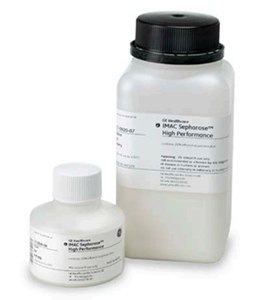Purification of Histidine-Tagged Proteins using IMAC Sepharose® High Performance
IMAC Sepharose® High Performance is an uncharged chromatography medium consisting of 34 µm beads of highly cross-linked 6% agarose to which a chelating group has been covalently coupled. This chelating group will be charged with suitable metal ions by the user, allowing the medium to selectively retain target proteins. The small bead size allows high chromatographic resolution with distinctly separated peaks containing concentrated material. The chromatography medium is highly compatible with a range of additives and is well suited to high-performance purifications that produce concentrated products in the eluate. Appendix 1 (Characteristics of Ni Sepharose®, Ni Sepharose® excel, TALON® Superflow, and uncharged IMAC Sepharose® products) shows the main characteristics of IMAC Sepharose® High Performance.
IMAC Sepharose® High Performance is supplied preswollen in 20% ethanol.

Fig 3.47. IMAC Sepharose® High Performance is supplied free of metal ions, enabling it to be used across a range of applications for purifying histidine-tagged as well as native proteins. It is available in 25 ml and 100 ml lab packs as well as prepacked HiTrap™ IMAC HP 1 ml and 5 ml columns.
Packing a column
See instructions supplied with the product, or refer to Appendix 6 (Column packing and preparation) for general guidelines for column packing.
Sample preparation
This sample preparation procedure is applicable for all formats containing IMAC Sepharose® High Performance.
Adjust the sample to the composition and pH of the binding buffer by adding buffer, NaCl, imidazole, and additives from concentrated stock solutions; by diluting the sample with binding buffer; or by buffer exchange. To prevent the binding of host cell proteins with exposed histidine, it is essential to include imidazole at a low concentration in the sample and binding buffer (Chapter 4, Optimizing purification of histidine-tagged proteins).
Pass the sample through a 0.22 µm or a 0.45 µm filter and/or centrifuge it immediately before sample application. If the sample is too viscous, dilute it with binding buffer to prevent it from clogging; increase lysis treatment (sonication, homogenization); or add DNase/RNase to reduce the size of nucleic acid fragments.
Buffer preparation
Water and chemicals used for buffer preparation should be of high purity. Filter buffers through a 0.45 µm filter before use. Use high-purity imidazole, as this will give a very low or no absorbance at 280 nm.
The optimal concentration of imidazole needed in the sample and buffer to obtain the best purity and yield differs from protein to protein. In the binding buffer, 20 to 40 mM imidazole is suitable for many proteins; 500 mM imidazole in the elution buffer ensures complete elution of the target protein.
Charging the chromatography medium with metal ion
- Prepare a 0.1 M solution of the desired metal ion (e.g., Cu2+, Zn2+, Co2+, Fe3+, or Ni2+) in distilled water. Salts of chlorides, sulfates, etc., can be used (e.g., 0.1 M CuSO4 or 0.1 M NiSO4).
Solutions of Zn2+ ions should have a pH of approximately 5.5 or lower to avoid solubility problems that arise at pH 6 or higher. Fe3+ ions should be immobilized at low pH (approximately pH 3.0) to avoid formation of insoluble ferric compounds.
- Wash the column with at least 2 column volumes of distilled water.
- Apply at least 0.2 column volumes of the metal ion solution to the column.
- Wash the column with at least 5 column volumes of distilled water to remove excess metal ions.
Wash only with water, not buffer, prior to applying the metal ion solution, otherwise unwanted precipitation may occur.
The column does not need to be stripped and recharged between each purification if the same protein is going to be purified. Reuse of any purification column depends on the nature of the sample and should only be performed with identical tagged proteins to prevent cross-contamination. For more information on this topic and on cleaning and storage, refer to Appendix 1 (Characteristics of Ni Sepharose, Ni Sepharose® excel, TALON® Superflow, and uncharged IMAC Sepharose® products).
IMAC Sepharose® High Performance is compatible with reducing agents. However, we recommend removal of any weakly bound metal ions before applying buffer/sample that includes reducing agents. This can be accomplished by performing a blank run without reducing agents (see below). Do not leave or store IMAC Sepharose® High Performance with buffers that include reducing agents.
Leakage of metal ions is low under all normal conditions. For critical applications, leakage during purification can be diminished by performing a blank run (as described below) before loading sample.
Blank Run:
Use binding buffer and elution buffer without reducing agents.
- Wash the column with 5 column volumes of distilled water (to remove the 20% ethanol).
- Wash with 5 column volumes of elution buffer.
- Equilibrate with 10 column volumes of binding buffer.
Purification
- If necessary, wash out the 20% ethanol with 5 column volumes of distilled water. Use a flow velocity of 50 to 100 cm/h. Refer to Appendix 8 (Converting from flow velocity to volumetric flow rates) for flow rate calculations.
- Equilibrate the column with 5 to 10 column volumes of binding buffer at a flow velocity of 150 cm/h.
- Apply the pretreated sample.
- Wash the column with binding buffer until the absorbance reaches the baseline.
- Elute with elution buffer using a step or linear gradient. For step elution, 5 column volumes of elution buffer are usually sufficient. For linear gradient elution, a shallow gradient, over 20 column volumes, may separate proteins with similar binding strengths.
- After elution, regenerate the column by washing it with 5 to 10 column volumes of binding buffer. The column is now ready for a new purification.
For A280 measurements, use the elution buffers as blanks. If imidazole needs to be removed, use a desalting column (Chapter 11, Desalting/buffer exchange, and concentration). Low-quality imidazole will give a significant background absorbance at 280 nm.
Materials
To continue reading please sign in or create an account.
Don't Have An Account?